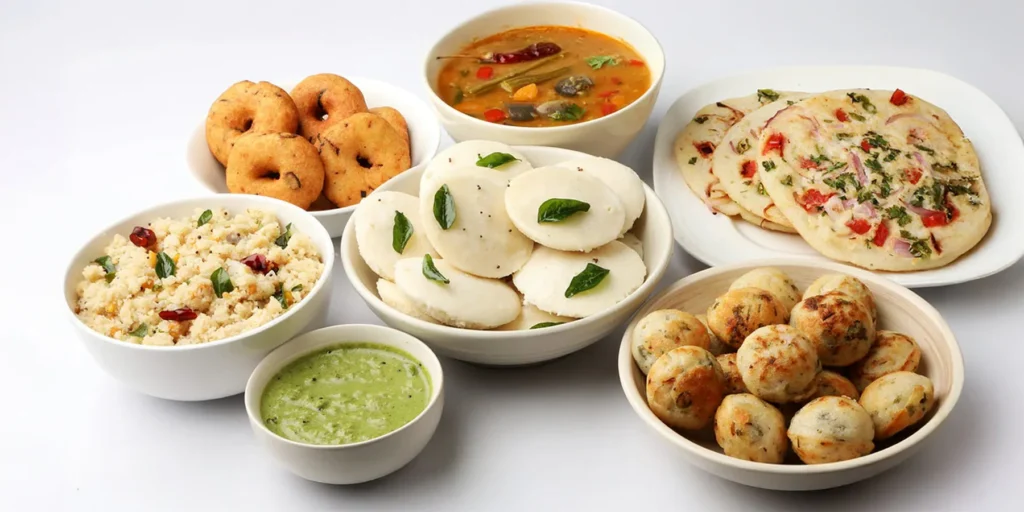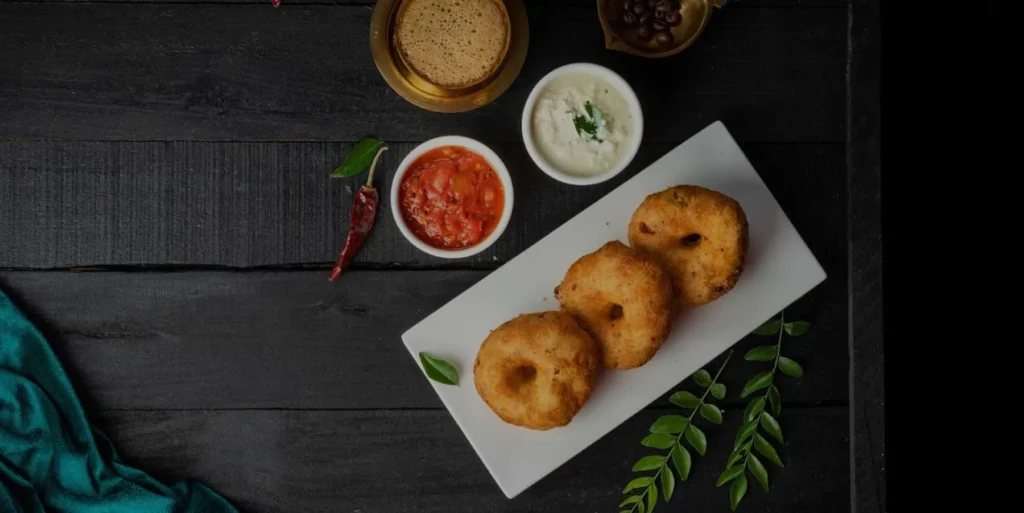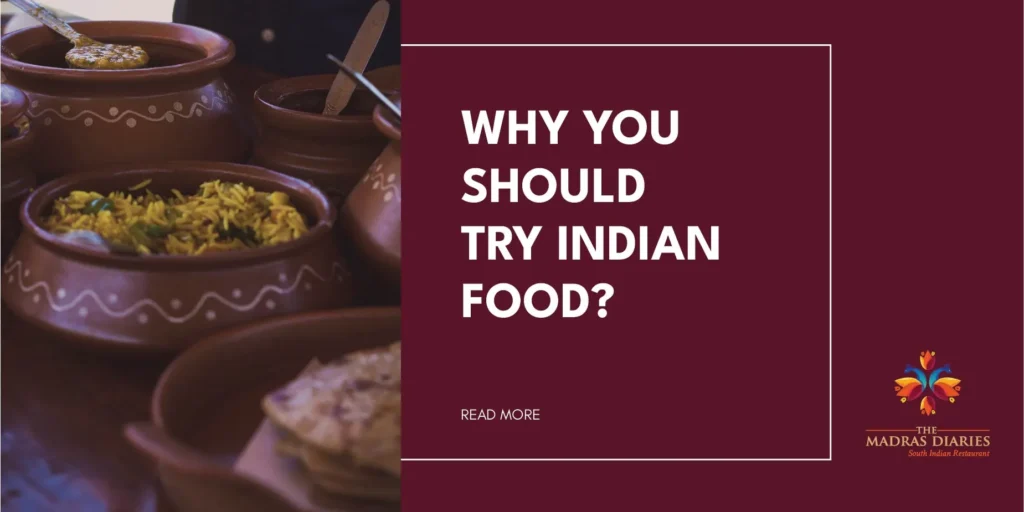You have likely heard about South Indian dishes and wondered whether it is as good for you as it tastes. After all, everyone wants to enjoy a meal that sits right with their health.
The food from this region is generally healthy thanks to its use of fermentation, fibre-rich lentils, minimal oil and digestive spices. Idli, Masala Dosa and Thali offer you a wholesome introduction.
So, let’s unpack the simple genius behind this cuisine – why it works and what to eat as a beginner.
Why Is South Indian Food A Smart Choice?
▪︎ The Fermentation Advantage
South Indian cuisine has long mastered the art of fermentation. It is not an expensive health trend. It has been a part of the households for generations now.
From Idli to Uthappam, fermentation plays a powerful role in how these staples nourish the body.
During the 8 to 12 hours that rice and urad dal batter sit quietly bubbling on the counter, natural lactobacilli break starches down, boosting B-vitamin content and making proteins easier to digest.
Nutritionists often suggest you have fluffy Idlis for breakfast because fermented foods help populate your gut with friendly bacteria, which in turn strengthens immunity and improves nutrient absorption.
▪︎ The Rice In The Room
‘Isn’t most of the dishes all white rice?’ sceptics might raise concerns. Sure, rice takes a prime spot, but Southern cuisine has a long history with millets such as Ragi (finger millet), Thinai (foxtail millet) and Kambu (pearl millet), among others.
Many homes rotate these ancient grains into Dosas and Porridges, trimming glycemic spikes. Even the rice story has nuance.
Traditional households lean toward parboiled, red or matta rice – grains with their bran intact and micronutrients still in good amounts. Yes, there are plenty of carbs in rice dishes. But consider portion size and accompaniments.
Between Cabbage and Carrot Poriyal (Stir Fry), Pachakari Kurma (Vegetable Curry), Keerai Masiyal (Mashed Spinach) and a bowl of rice, the regular meals here balance taste, texture and nutrition beautifully.
Curious why rice is a staple in South Indian kitchens? Head over to our blog now!
▪︎ A Healthy Plate
Lentils are also used widely here – toor (pigeon pea) in Sambar, moong (green gram) in Payasam and urad (black gram) in Dosa batter. A single serving of Sambar gives you about 10 to 12 grams of plant protein.
Pair it with Egg Thokku or a cup of Curd Rice and you are cruising past the protein mark without breaking a sweat.
Ivy gourd, snake gourd, drumsticks, red amaranth, raw banana and pumpkin are all featured in everyday gravy. More colours on the plate equal more phytonutrients.
For non-vegetarians, Gramathu Meen Kuzhambu, Meen Polichathu, Karur Mutton Salna, Nandu Milagu Perattal or Royyala Vepudu gives you a tasty shortcut to meet your protein goals.
Steaming (Puttu), pressure-cooking (Paruppu Curry), slow-simmering (Vathal Kuzhambu) and quick stir-fries (Beans Poriyal) dominate home kitchens.
Deep-frying exists but rarely enters daily menus. The emphasis on water-based cooking reduces calorie density while retaining vitamins.
▪︎ Spice As Medicine
The ‘Anjarai Petti’ or South Indian spice box is basically a mini treasure chest packed with healing ingredients.
Mustard seeds kick-start digestion, cumin seeds support your immune system, coriander seeds help in detoxification and turmeric, the superfood, fights inflammation and reduces gastric troubles.
Grandmas trust Rasam when you catch a cold. Well, that is not any hot broth, but homemade magic in a bowl. Tamarind delivers vitamin C, while garlic keeps microbes on their toes. One steamy sip and your sinuses just open up.
And, when these spices are tempered, they bring flavour and release bioactive compounds. Most of the dishes are sauteed, not deep-fried, so you get flavour without clogging your arteries.
Sesame oil in Tamil Nadu, cold-pressed coconut oil in Kerala and the occasional drizzle of groundnut oil in Karnataka, each arrives unrefined and packed with heart-friendly mono and polyunsaturated fats.
▪︎ The Love For Coconut
While the rest of the world spent the last decade debating whether coconut is friend or foe, South India just kept cooking.
Freshly grated coconut is included in chutneys, curries and even desserts without apology. Yes, it contains fat, but mostly medium-chain triglycerides, which the body burns for quick energy instead of storing.
And, the key word is moderation, something every seasoned cook understands in their bones. A tablespoon for an entire pan of Avial (mixed vegetables in coconut gravy) is within your calorie budget.
So, is South-Indian food healthy?
When you honour its traditional balance – yes, emphatically so. The cuisine is an advocate of mindful eating, centuries ahead of modern ‘food pyramids.’
It is an edible philosophy, one that says nourishment and pleasure can and should coexist at the same table.
What To Order If You Are A First-timer?
- Starters
A vegetarian take on the traditionally meat-heavy kola urundai, Beetroot Kola Urundai is a surprise treat. You pop one in your mouth and the explosion of mild sweetness, heat and crunch hits just right.
The Chemmeen Fry is a staple along Kerala’s backwaters. Crispy on the outside and juicy inside, it is simply addictive. Now, if you are someone who prefers meat, Mangalorean Mutton Chukka is a flavour punch you did not know you needed.
- Breads
Ah, the king of flaky bread, Malabar Parotta! With its beautiful layers and slightly crisp edges, Malabar Parotta is a dish in itself. Tear it with your hands, dip it into a spicy curry and you will know why it is such a beloved treat.
Thin, soft rice flour flatbread, Pathiri, can be best enjoyed with mildly spiced coconut-based curry. It is robust, rich and absolutely flavoursome.
- Tiffin
Thattu Idlis are fat, soft pillows of rice-lentil batter. They are slightly larger than the regular ones. Pair with spicy tomato chutney or ghee and milagai podi (gunpowder) and you will be hooked.
Masala Dosa is a classic but still worth every mention. The crispy crepe made from fermented rice-lentil batter is stuffed with a spiced potato filling and served with coconut chutney and sambar. No matter how many times you have it, it always feels heavenly.
- Curries
Arachuvitta Sambar is prepared with freshly ground spices and coconut. It has a thick, gravy-like consistency and is loaded with vegetables like drumsticks. Pair it with steaming rice or Idli and relish in happiness.
A mildly spiced fish curry with coconut milk, Kannur Meen Moilee is aromatic, light and perfect with Appams or rice. The flavours slowly grow on you and you might never want anything but this curry.
The meat in Kozhi Chettinad is cooked until it falls off the bone well. The spicy, bold flavours make you drool every time you think of it. Trust us, you have to try it.
- Rice Dishes
If you are new to South Indian food, start with a Thali. A thali is not just a meal, it is an experience. Small servings of Sambar, Rasam, Kootu, Poriyal, Curd, Oorugai, Payasam and Appalam served with rice. Each bite takes you on a small journey.
You taste tang, heat, crunch and comfort all in one sitting, and you will leave smiling and satisfied. A crowd-puller if there ever was one, Hyderabadi Gosht Dum Biryani is a dish you shouldn’t miss.
Cooked on dum, a slow-cooking method, this biryani traps the juices of marinated mutton in long-grain basmati rice. Honestly, no adjectives will ever be enough to tell you how delectable this biryani is.
- Desserts
Prepared with generous amounts of ghee, sugar and gram flour, Mysore Pak is crumbly, slightly grainy and melts in your mouth like a dream.
The sweet ending to any South Indian meal, Payasam comes in many versions with vermicelli, lentils, rice or broken wheat.
But all of them have one thing in common – they are slow-cooked, milk-based and rich with jaggery, cardamom and ghee.
And, if you ever come across Elaneer (tender coconut) Payasam, do not think twice. Just go for it. You can thank us later!
- Drinks
You have not really had coffee until you have had Filter Kaapi. It is iconic. Brewed in a metal filter and mixed with hot milk and sugar, this coffee is strong and frothy and served in a steel tumbler and dabara (a small cup and saucer).
Nannari Sarbath is the ultimate summer cooler. It is the drink that makes you pause and sigh with relief on a hot day. Also, it is good for digestion. A win-win, we must say!
If your stomach’s already convinced and you are halfway out the door to the authentic South Indian eatery nearby, we have got something to tell you – The Madras Diaries is hands down the place to be.
Nope, we are not about to ramble on with never-ending praise, but our fine dining restaurant genuinely speaks for itself and there is a reason why people keep coming back.
So, let your next meal be something to remember. Join us soon!



